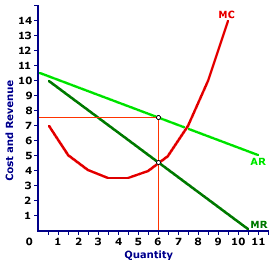Monopoly maximizes profit by producing the quantity of output that equates marginal revenue and marginal cost. In that price (and average revenue) is greater than marginal revenue for a monopoly, price is also greater than marginal cost. Monopoly does not produce output by moving up and down along its marginal cost curve. The marginal cost curve is thus not the supply curve for monopoly.As a price maker that controls the market, monopoly reacts to demand conditions, especially the price elasticity of demand, when setting the price and corresponding quantity produced. While it is not out of the question that monopoly offers a larger quantity for sale at a higher price, it is also conceivable that it offers a smaller quantity at a higher price or a larger quantity at a lower price.
Working a Graph
Profit Maximization,
The Marginal View |  |
Consider the production and sale of Amblathan-Plus, the only cure for the deadly (but hypothetical) foot ailment known as amblathanitis. This drug is produced by the noted monopoly firm, Feet-First Pharmaceutical.A typical profit-maximizing output determination using the marginal revenue and marginal cost approach is presented in this diagram. Feet-First Pharmaceutical maximizes profit by producing output that equates marginal revenue and marginal cost, which is 6 ounces of Amblathan-Plus in this example. The corresponding price charged is $7.50.
What might happen, however, with a change in demand--in particular, a demand that leads to a higher price? For a perfectly competitive market, a higher price induces a larger quantity supplied as the market moves from one equilibrium to another, along a positively-sloped supply curve. The supply curve is positively sloped because it is comprised of positively-sloped marginal cost curves for every firm in the market.
Does this also happen for a monopoly? It might. But then again, it might not. Click the [Demand Shift] button to illustrate this shift. Note that the demand curve does not simply shift, slope (and elasticity) also change. This is the key.
Check out the new equilibrium. The monopoly seeks the production level that maximizes profit, just as it did before, by equating marginal revenue and marginal cost. This production level is 5 ounces, which is LESS than the original 6 ounce production level. The subsequent price charged by Feet-First Pharmaceutical is $9, obviously greater than the original $7.50 price.
Working Demand
So what has happened here?The monopoly reacts to the changing price elasticity of demand. The new demand curve is less elastic. Buyers are less responsive to price changes. The monopoly takes advantage of this when setting the price and quantity that maximizes profit.
It not only raises the price, but the less elastic demand also makes it possible for the monopoly to reduce the quantity. The monopoly firm does not merely respond to the market price, as would happen for perfect competition, it "works the demand curve." Feet-First Pharmaceutical moves along the demand curve to find the best price-quantity combination available. And it can do this because it is a monopoly, with market control. It is a price maker.
Maybe a Supply Curve, Maybe Not
This analysis is not meant to imply that monopoly DOES NOT produce a larger quantity in response to higher price. It only indicates that it MIGHT NOT produce a larger quantity in response to higher price. However, the phrase "MIGHT NOT" is extremely important to the law of supply. Economic science pursues universal laws and economic principles that ALWAYS hold. In particular, the key obstacle to the positive price-quantity supply relation is market control and the negatively-sloped demand curve facing the monopoly. As a matter of fact, any firm with market control, which includes all market structures EXCEPT perfect competition, has the same qualification about supply. And because perfect competition does not exist in the real world, all real world market structures have questionable supply curve relationships.
This is perhaps most important because implementing policies that are based on economic laws that may or may not hold can be troublesome. Given the realistic possibility that the law of supply does not hold, the application of market-based policies can prove difficult, especially if the policies presume that firms react to higher price by increasing the quantity supply.
MONOPOLY, SHORT-RUN SUPPLY CURVE, AmosWEB Encyclonomic WEB*pedia, http://www.AmosWEB.com, AmosWEB LLC, 2000-2025. [Accessed: July 18, 2025].


